In Inter Milan’s efforts to close the gap between themselves and Juventus, they have been diligent in the transfer market to bring in players that will have the side capable of competing for the Serie A title. One of the major additions in this process came in January with the arrival of Christian Eriksen from Tottenham Hotspur.
This tactical analysis will focus on the alterations Antonio Conte has implemented in his system to accommodate the Danish international. The side have remained true to their three-back formation methods, but the midfield structure has altered with Eriksen’s presence in the team.
Midfield Shift
To begin the campaign, Conte opted to deploy his Inter side with one holding midfielder and two more advanced central midfielders given the freedom to move further up the pitch. This typically included Marcel Brozovic occupying the single-pivot role for the side. His ability to dictate the tempo of any match allowed this structure to be effective in holding and recycling possession in the attacking phase of play.
Higher up the pitch, we have seen the likes of Stefano Sensi, Nico Barella, Matias Vecino, Roberto Gagliardini, and Borja Valero split time rotating in between the remaining two midfield positions in this system. Sensi, in particular, thrived in this role. These midfielders were allowed to push forward as they were the primary support to Inter’s two strikers.
With Eriksen’s addition to the side, this system shifts to two holding midfielders in a double-pivot, leaving one advanced midfielder, Eriksen, to provide the main connection to the forward line. Inter’s typical structure and personnel is shown in the image below.
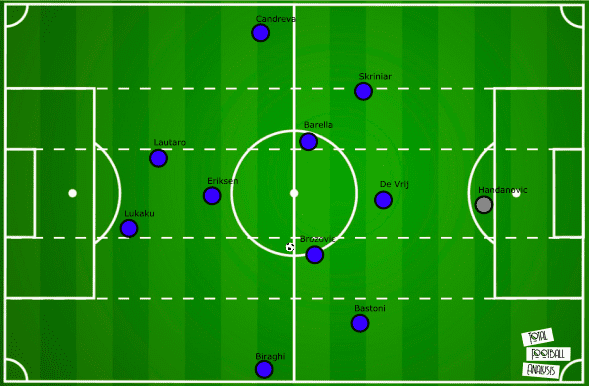
This analysis will look to detail the positional rotations in Inter’s attacking phase that this change in midfield structure has brought. It will be divided into higher positional rotations between Eriksen and the strikers before going into lower positional rotations involving the wing-backs, double-pivot, and centre-backs. The final section will discuss how this shift in set-up could go about bringing the best out of Barella in the future.
High positional rotations
A staple of Conte’s attacking system are positional rotations that work to move the opposition out of shape and exploit space. Since Eriksen’s arrival and more specifically the restart of the Serie A campaign, the rotations we see from the Nerazzurri have shifted.
Eriksen consistently moves throughout Inter’s attacking phase; however, a lot of the time this is for the sake of opening space. A common area we have seen the creative midfielder move into is the forward line. Here he looks to work off of the movement of the two strikers in order to create space for his side to move possession forward. As Eriksen steps forward, it forces the central defenders of the opposition to stay central to restrict space for him to receive to feet or in behind. In response to this movement, the ball-side striker drops deep into the half-space to provide an outlet for the Inter central defender or central midfielder in possession. We can see this concept in the image below.
As Milan Skriniar holds possession, Romelu Lukaku holds a deep position in the midfield rather than pressing forward with the forward line. This is done to offer a forward option in which Lukaku can then look to lay a pass off out wide to the wing-back or into one of the central midfielders. In turn, Eriksen steps forward to pin the centre-backs, stopping them from stepping forward to mark Lukaku and instead protect the space in behind. You can see the Sassuolo wing-back pointing out Lukaku for the midfielder to pick up and mark, as he is unable to do so as well due to the risk of leaving the channel open for Victor Moses to look to exploit.
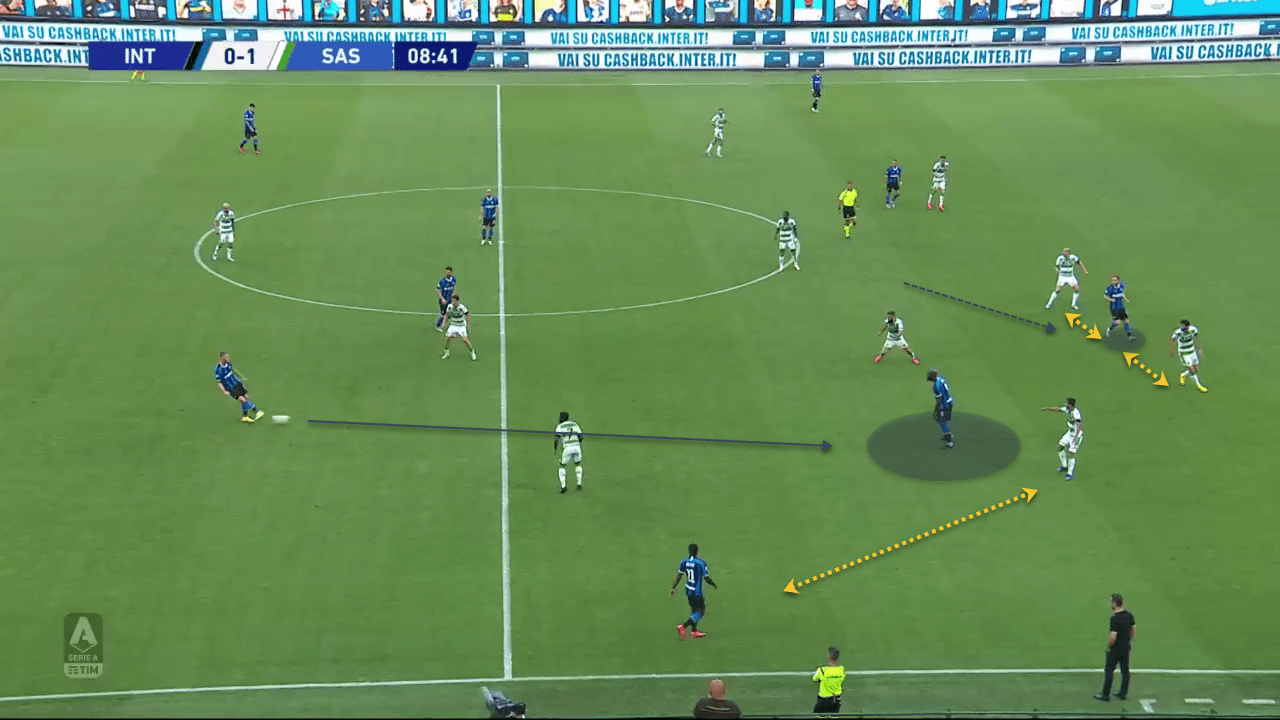
Another rotation Inter Milan look to use when the striker drops into midfield is one of the central midfielders running in behind. We typically see this when the wide centre-back is in possession and looking to play through the middle or half-space. When the striker drops off to present a passing option, the wing-back will cut inside to show for a lay-off from the forward. From here this player looks to play a pass into the central midfielder running in behind into the vacant area in the opponent’s defensive line or for a cross-field pass to a player in an isolated situation.
This set of positional rotations is aimed to move the opponent’s block to try and converge centrally as the striker and wing-back move into this area. The majority of Italian sides use a man-marking defensive system, which gives the ability for attacking players to move their markers out of position should they be successful in their rotations.
Once the initial pass is made into a central position and the defensive structure of the opponent attempts to constrict the space, Inter quickly look to expand play in order to take advantage of space in other areas of the pitch.
In the image below you can see possession with Skriniar just inside the Sampdoria half. Barella finds a pocket of space in behind the opponent’s midfield line and quickly moves into it to evade his markers. As he pushes forward, Lukaku acknowledges his forward movement and drops in to offer support in midfield in place of the Italian. Skriniar then finds this pass into the feet of the striker.
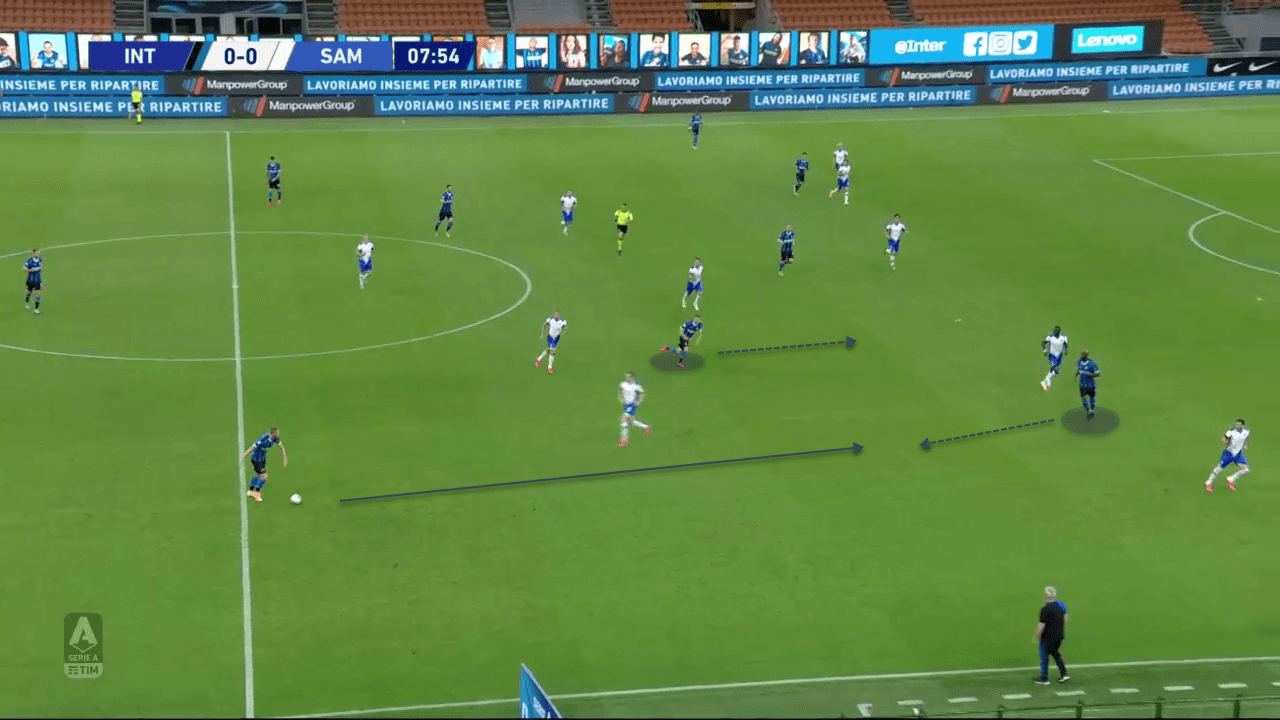
Barella continues his run into the attacking third of the pitch. As Lukaku drops deep, Candreva comes inside to offer support. The movement of these two cause the two defenders on this side of the pitch to step up centrally. This creates a massive gap Barella is able to run into. Candreva’s movement allows him to be in position to receive a lay-off from Lukaku and play a through pass into Barella’s run if he chooses this option.
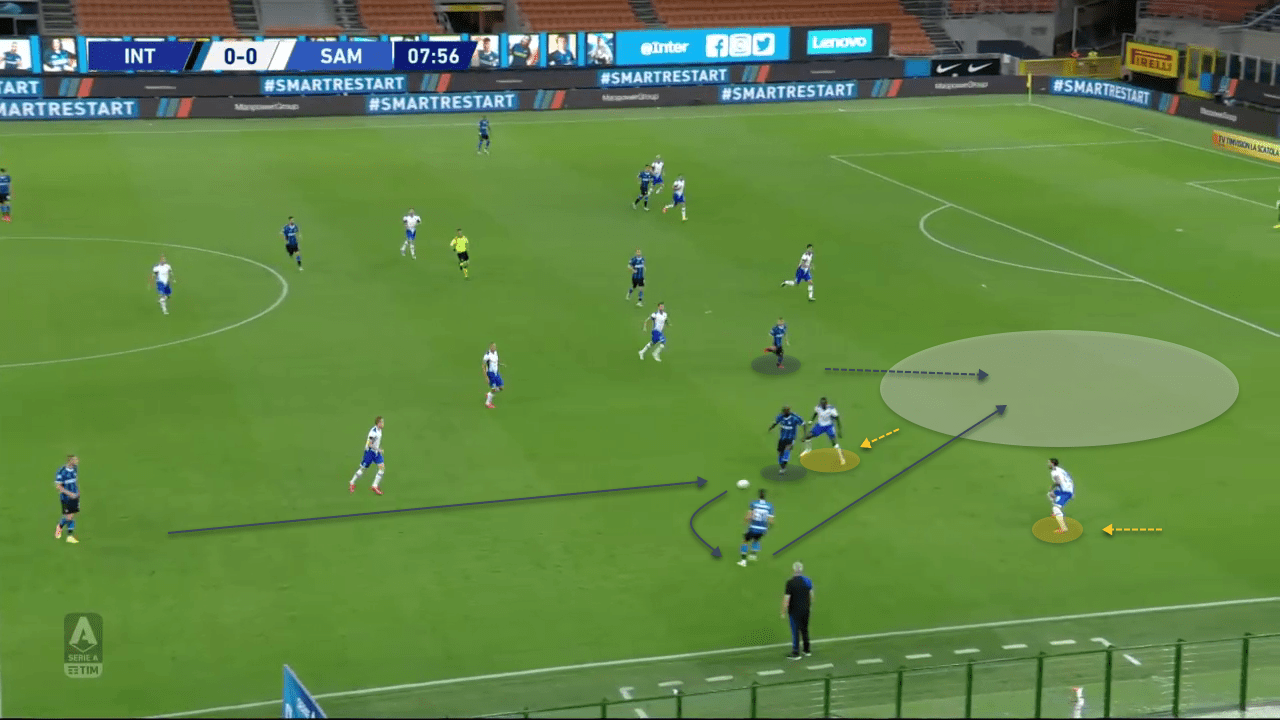
Low positional rotations
The rotations in the initial build-up phase for Inter is possibly the most interesting alteration since this shift in structure. The presence of two deep-lying midfielders has given Conte more flexibility in these tactics.
The most common rotation we see is between the wide central defenders and their same-side central midfielder. Ball progression into the attacking third has often come from these defenders, as their midfielder tucks into the space in behind to provide cover in the rest defence. Specifically, Bastoni has shown a strong ability in carrying possession forward for his side. Due to this ability, he is frequently taking opportunities and moving possession through the channel or into the half-space, dependent on the movement of the players ahead of him.
The centre-backs movement works in line with the wing-backs. These two players are the primary width providers for Conte’s side. If the wing-backs stay close to the touchline, the centre-backs will look to progress play through the half-spaces, either with a dribble or pass.
The most common rotation in this structure was described in the last section with a pass into the striker who has dropped into the midfield.
Since this shift in midfield structure, a movement we have seen much more has been the centre-backs overlapping. This is a direct result from having the presence of two holding midfielders, meaning there is a midfielder available to drop into the space vacated by a wide centre-back much quicker. As this centre-back moves forward, the wing-back rotates into the now vacant space in the centre of the pitch to drag the oppositions’ cover away from the wide area.
Moving the midfielders into deeper positions also gives Conte’s side the best opportunity to make use of the passing ranges of their central midfielders. With holding players such as Brozovic and Barella, who we will go into detail with in the following section, they are able to dictate attacking moves from deep positions and move play as necessary at a high speed, or slow down and control the game when needed as well.
Moving central defenders into advanced roles can cause major issues for defending teams as well. Defensive teams must stay diligent in tracking backwards, specifically the attacking players in this scenario, but they must weigh this appropriately with continuing to provide an outlet for their side. If this balance is not achieved the defending side will either allow their opponents to create numerical superiorities in dangerous areas or get pinned in too deep with no outlet to move into when possession is won.
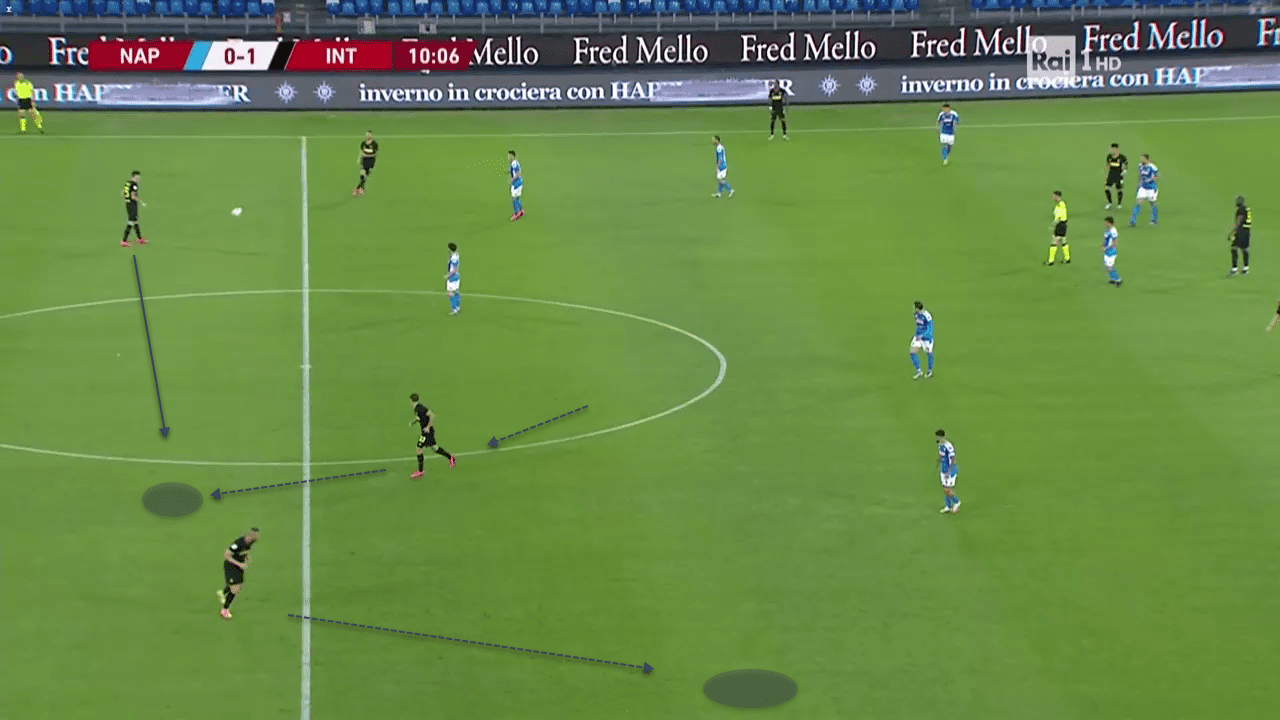
In the image above, Inter work their attack down the left before deciding to recycle possession back to the right side. As this move develops, Barella drops into the defensive line and allows Skriniar to advance into the wide area. Inter create these positional rotations early to not allow the defensive team time to orientate themselves properly before they begin their attack in the new area of the pitch.
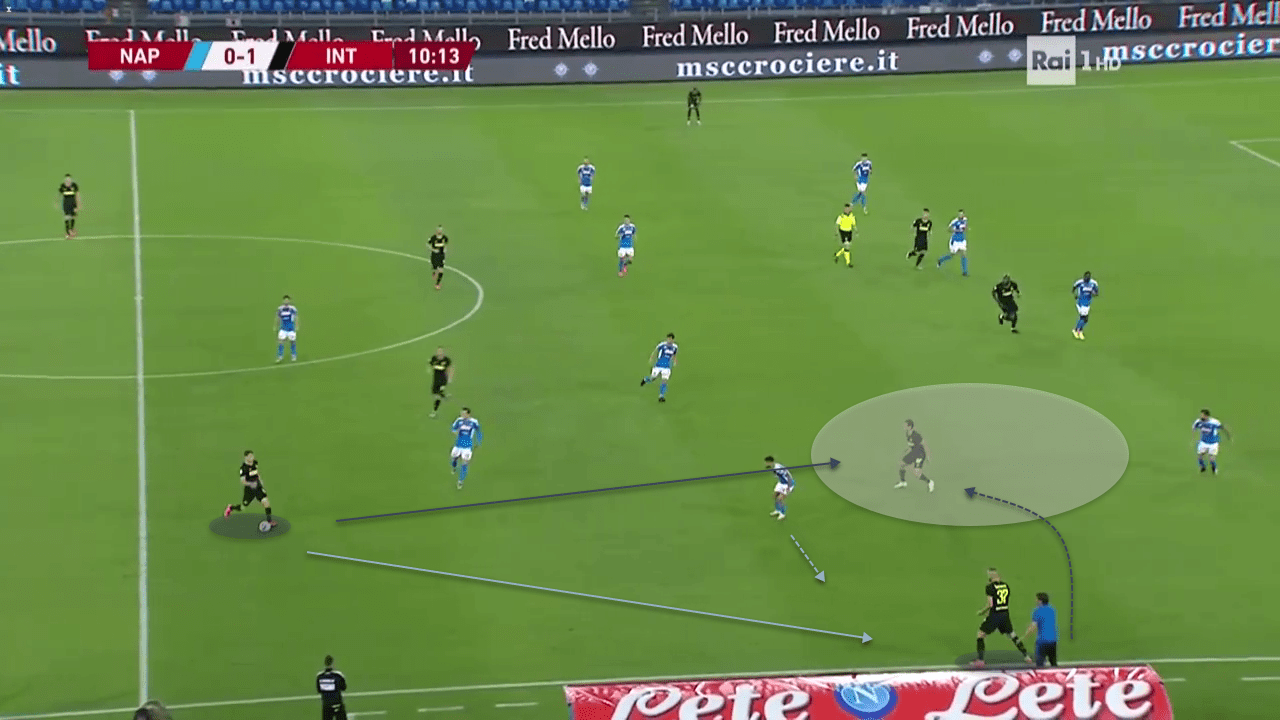
Now with Barella in possession in this deep position and Skriniar pushing forward, Candreva moves into the space behind Napoli’s midfield line in the half-space. Intelligently, Barella identifies this space his wing-back has found, and fakes a pass out wide to Skriniar in order to shift the position of the outside midfielder of Napoli thereby opening a passing lane into Candreva in this space.
Impact on Barella
A player who has shone bright since this shift has been the first-year signing Barella. The former Cagliari man had a rough beginning to the season and was regularly in and out of the side. Part of this was down to the spectacular form of Sensi. However, a primary cause of this was due to the system. Sensi strived in a free role where he was able to roam forward looking for pockets of space between the midfield and defensive lines of the opposition to exploit, playing off of and getting in behind his teammates in the forward line.
Barella is a different type of player. He is at his best holding a deeper position and looking to dictate play. He still has the ability to move forward and drive into space opened up higher up the pitch, but these movements are more calculated and fewer than that of his compatriot Sensi.
A small sample size must be taken into account, but the effects of this transition are already beginning to be seen with Barella through statistics. To start with, he is averaging 70.33 passes per 90 (83.67% accuracy) over the past three games since the restart, as compared to his 49.31 average this season (84.9%). This emphasises the larger role in Inter’s possession play Barella has had in this new structure. He has been an integral part of their build-up play and transition from their own half into the opposition’s territory. He has completed 12 progressive runs in his three appearances in comparison to his 1.42 average this campaign. 24 of his pass attempts have been forward compared to 14.67 throughout the season, with an improvement in completion percentage from 75.9% to 79.67%. Lastly, his 8.33 passes to the final third average has jumped to 16.67 over the past three matches, with his completion rate only slightly dropping from 76.33% to 74.7%.
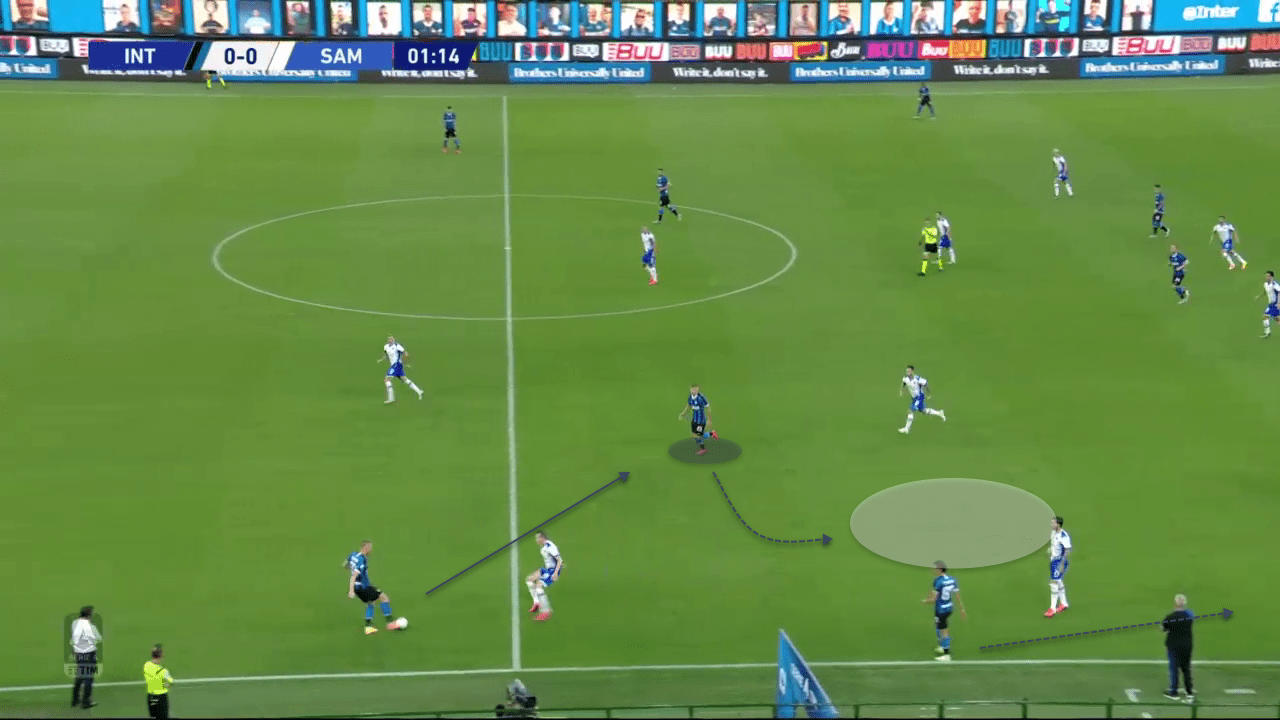
In this image, Barella is occupying his new deeper position for Inter Milan offering a passing lane for Skriniar. He is at his best dropping into these areas away from his defensive marker and pulling the attacking strings from here. As Skriniar makes the pass centrally into the midfield, Candreva pushes forward to create more space for Barella. The former Cagliari man identifies this space and pushes his first touch wide to take advantage of it.

As he gains a step on his marker he pushes up field and assesses his options. He quickly sees Candreva has continued his forward runs and makes a brilliant chipped through ball into the final third for his wing-back to run onto and put a cross into the box. Lukaku has aided this by coming short to give an option which dragged his centre-back out of the defensive line and allowing more space in behind.
Conclusion
Although it looks like Inter Milan will fall short this campaign in their efforts to secure their first Serie A title since 2010, there are many positives to be taken moving forward. With the potential arrivals of Sandro Tonali and Achraf Hakimi, along with other possible other targets, Conte’s side will return next season ready to challenge Juventus for the crown once more. This time, they will come prepared with more experience in a system that allows for them to play more fluid and dynamic attacking football, as well as suiting their personnel better than previous structures. Eriksen’s presence in the midfield will have a huge impact on Inter’s success moving forward and it is only fitting that this new formation is built to work around bringing the best out of the Danish international.

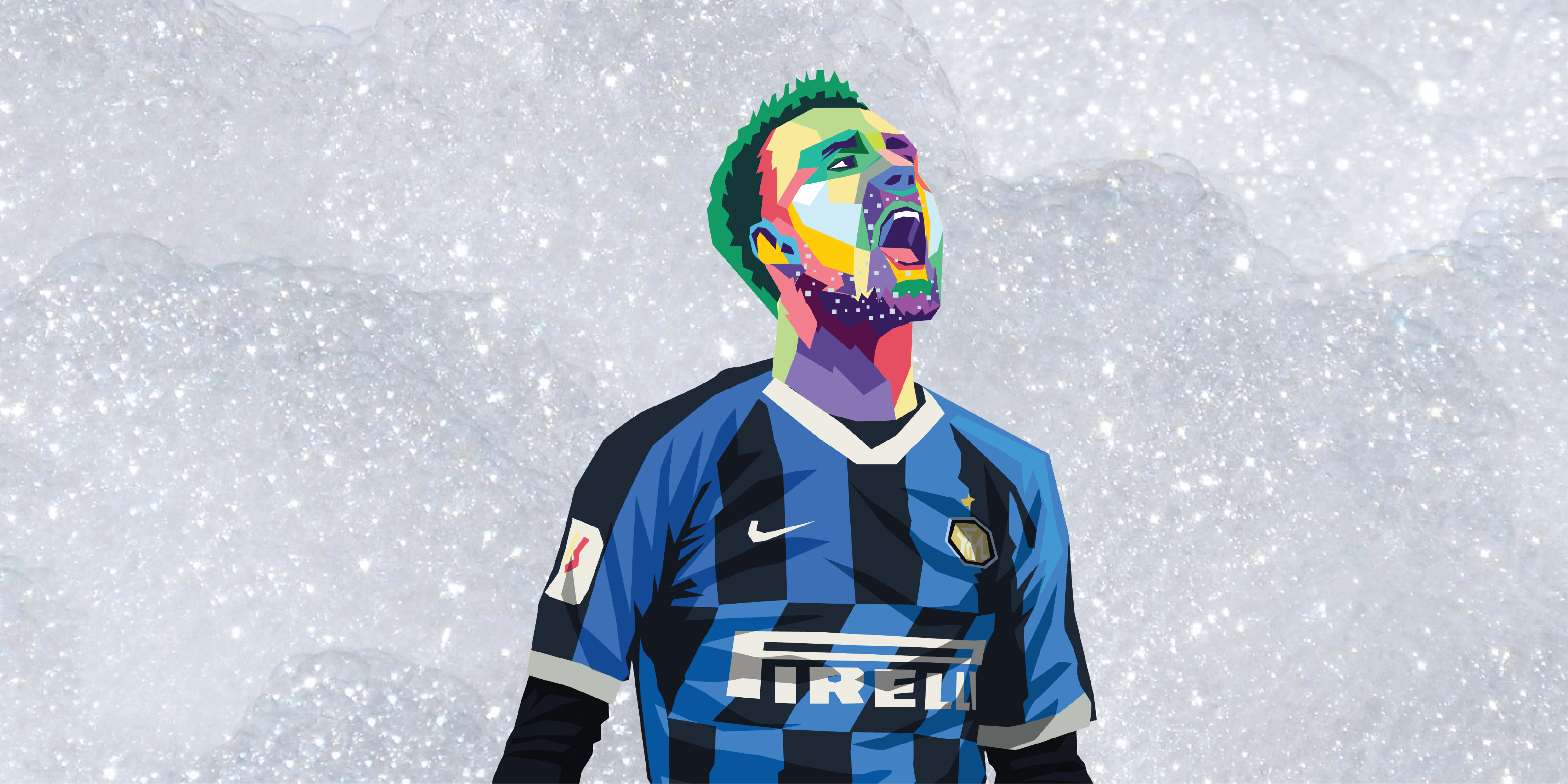




Comments